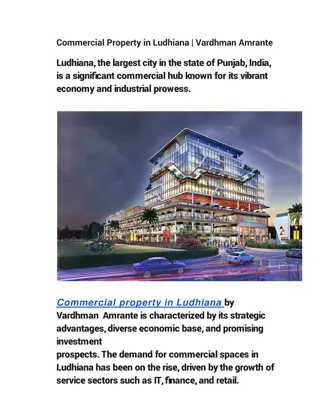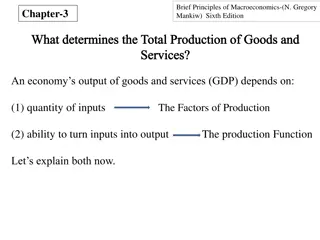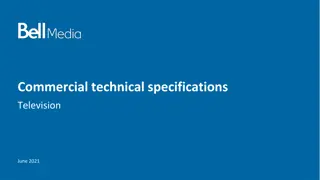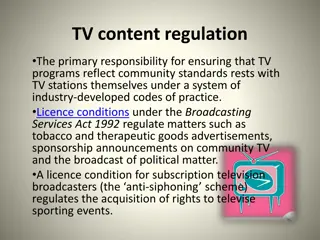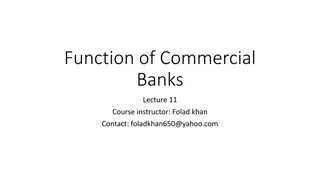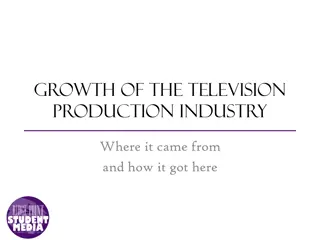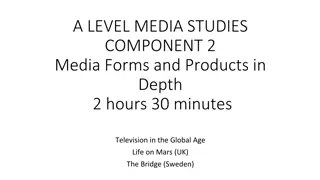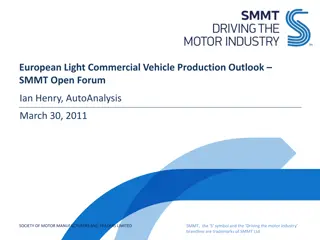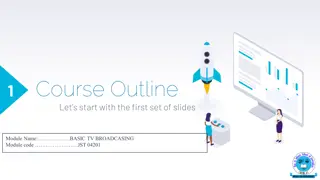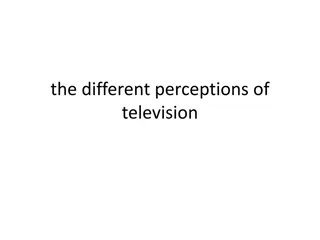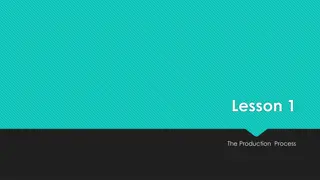Understanding Television Commercial Production Process
Television commercials (TVCs) play a crucial role in advertising, promoting products, services, and ideas to a wide audience through television broadcast. This comprehensive guide covers the definition of TVCs, their objectives, steps in the production process (pre-production, production, post-production), and the tasks involved in each stage. It also delves into the importance of TVC production, from launching new products to extending product life cycles and convincing consumers to switch brands. Dive into the world of TVC production and enhance your understanding of this vital advertising medium.
Download Presentation

Please find below an Image/Link to download the presentation.
The content on the website is provided AS IS for your information and personal use only. It may not be sold, licensed, or shared on other websites without obtaining consent from the author. Download presentation by click this link. If you encounter any issues during the download, it is possible that the publisher has removed the file from their server.
E N D
Presentation Transcript
TELEVISION COMMERCIAL TELEVISION COMMERCIAL PRODUCTION PRODUCTION Advertising Management Advertising Management Dr. Sudesh Srivastava Associate Professor - Marketing Area Institute of Business Management CSJM University, Kanpur
What is a TVC? What is a TVC? A television commercial (TVC) is a form of advertising where goods, services, organizations, ideas, etc. are promoted through television broadcast. Usual duration of a TVC in India : 3 minutes 60 seconds 45 seconds 30 seconds 15 seconds 10 seconds
Objectives of a TVC Objectives of a TVC A Television commercial helps a marketer to Launch a new product Launch a modified product Extend the Product Life Cycle Convince the customers to switch brand/product Remind the consumer etc..
Steps in the TVC Production Process Steps in the TVC Production Process Pre-Production Production Post-Production
Pre Pre- -Production Production Pre-production is a general term that refers to the various tasks undertaken before the production begins. The tasks included in this stage depend upon the medium and situation. For an advertising agency creative team, pre-production may refer to everything that happens before the photography/shooting begins, e.g., meeting with the client, research, storyboarding, location planning, etc.
Pre Pre- -Production .. Production ..contd. contd. Pre-production includes: Location search Props and wardrobe identification and preparation Special effects (SFX) identification and preparation Scheduling production Set construction Locking the script (semi-finalisation of the script) Script read-through with cast, director and other related parties
Production Production Production is that part of the process where the footage is shot/recorded. This is what laymen imagine when they think of a film being made actors on sets, cameras rolling, etc. The production phase is also known as principal photography. In full length feature films the beginning of the production phase marks the "point of no return", i.e. the point at which it is no longer financially viable to cancel the project. At this point it is almost always cheaper to continue until the project is finished than to deal with the financial losses incurred upon cancelling the shoot.
Production Production ..contd. ..contd. Thus, the main objective of principal photography is to record all required shots (however it is fairly common to shoot "pick-up" shots in post-production). Pick-up shots are required when a mistake is noticed, a script change is made (not often), or when a performance is deemed to be unsatisfactory.
Post Post- -Production Production Post-production is the third and final stepof the TVC production process. In the parlance of the advertising world, it is often referred to simply as post, ("We can sort that out in post ) Common tasks in Post-Production include, but not limited to: Editing the video footage Editing the soundtrack, adding sound effects, music, etc. Adding titles and graphics Colour and exposure correction Adding special effects Re-shooting certain scenes if required ("pick-up" shots)
Post Post- -Production Production contd. contd. Sometimes, the post-production is comparatively simple, consisting of just selecting and arranging footage in the desired sequence. In most cases, however, post-production involves time-consuming tasks, often taking longer than the actual production phase.
Some Tips for Creating Effective TV Some Tips for Creating Effective TV Commercials Commercials Begin at the finish. one should focus on the final impression the commercial will. The opening should grasp the attention of the audience An opening that is visually surprising or full of action, drama, humor or human interest sets the context and allows a smooth transition to the rest of the commercial. One should use a situation that grows naturally out of the sales story. Avoid distracting gimmicks. Make it easy for viewers to identify with the characters.
Some Tips for Creating Effective TV Some Tips for Creating Effective TV Commercials Commercials contd. Characters personify the product. They should be appealing, believable, non-distracting and relevant. One should try to keep it simple. The sequence of ideas should be easy to follow. Keep the number of elements in the commercial to a minimum. Write concise audio copy. The video should carry most of the weight. Fewer than 2 WPS is effective for demonstrations. For TVCs, 101-110 words is most effective. More than 170 words is too talky. contd.
Some Tips for Creating Effective TV Some Tips for Creating Effective TV Commercials Commercials contd. Demonstrations should be dramatic but believable. They should always be true to life and avoid the appearance of camera tricks. Let the words interpret the picture and prepare viewers for the next scene. Use conversational language; avoid ad talk. Run scenes five or six seconds on average. Rarely should a scene run less than 3 seconds. Offer a variety of movement-filled scenes without jumping . contd. dairymilkold.mp4
Filming techniques Filming techniques SHOT Basic visual element in a film Continuous view made by one camera without interruption Each shot is a take. A number of takes may be required to make one acceptable shot A scene may consist of one or more shots taken from different angles and distances
Three Important Considerations Three Important Considerations 1. Area included in the shot 2. The viewpoint 3. Camera angle
The area included in the shot The area included in the shot Extreme Long Shot (ELS) Panoramic shot that shows a great area seen from a distance Establishes geographical setting or scenic beauty
The area included in the shot The area included in the shot Long Shot (LS) Less panoramic and a little more specific than the ELS. Setting could be established but the viewer will be better able to pick out and relate to specific individuals within the shot Used to establish all elements in the scene, so that viewers will know who is involved, their location, etc
The area included in the shot The area included in the shot
The area included in the shot The area included in the shot Medium Shot (MS or MED) People are filmed about waist high. Camera is close enough to capture gestures, expressions and movements Most common type of MS is two-shot, in which 2 characters exchange dialogues MS are good re-establishing shots after series of close-ups to help reorient viewer to the larger scene, action or setting
The area included in the shot The area included in the shot (Kendall Jenner Pepsi) (Kendall Jenner Pepsi)
The area included in the shot The area included in the shot Close Up (CU) CU of a person includes head and shoulders. Variations include: medium CU (between waist and shoulders to above the head), head CU (head only), and choker CU (below lips to above the eyes) Basic use of CU is draw attention to a significant detail such as unique product feature or the emotional reactions of an actor. Backgrounds should be kept simple or simply out of focus 2 basic editing uses of CU: Cut-in CU is a CU of a preceding larger shot to heighten dramatic dialogue, isolate significant detail, magnify small-scale action, etc. Cut-away CU is a CU related to but not part of the previous scene. It depicts action simultaneously happening elsewhere.
Close Up (CU) Close Up (CU)
The area included in the shot The area included in the shot Extreme Close Up (ECU) Focus attention on detail of a detail. Tiny objects or areas, small portions can be magnified.
Extreme Close Up (ECU) Extreme Close Up (ECU)
Different Shots. Amity Ad Amityuniversity.mp4
The Viewpoint The Viewpoint Objective-impersonal. Viewpoint of a sideline observer. Characters do not look at the camera.
Objective Viewpoint Objective Viewpoint
The Viewpoint Subjective-Personal Involved viewpoint (audience or one of the characters). Characters look directly at camera.
Subjective Viewpoint Subjective Viewpoint
Camera Angle Camera Angle Eye Level: sense of equality, attainable
Camera Angle Camera Angle Looking down (high angle): Gives viewer a sense of superiority on the subject. Makes subject appear inferior
Camera Angle Camera Angle Looking up (low angle): Gives a sense of height or superiority to the subject.
Production of advertisements Amul Ad making making of amul ad.mp4
Thank You Thank You






